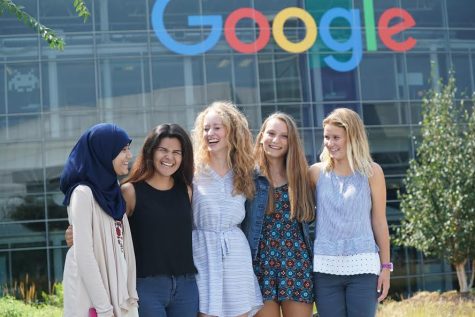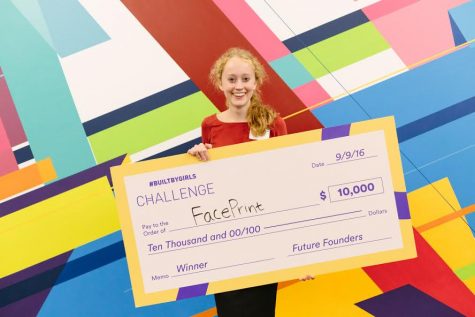FacePrint
Just by looking at someone’s face for a few milliseconds, technology can now tell whether or not they have Parkinson’s. This is in part thanks to junior Erin Smith.
Erin Smith presenting the pitch for her app, Faceprint.
October 24, 2016
Our faces are one of the most important physical attributes of our bodies. They distinguish who we are, how we feel and sometimes even what we are thinking. However, our faces can also reveal facts much more serious.
Through the power of biomarkers, facial recognition software and machine learning algorithms, junior Erin Smith has found a way to detect the early stages of Parkinson’s disease.
Parkinson’s disease slowly and increasingly causes the death of nerve cells in the brain, which in turn, decreases ability to move precisely and causes tremors, stiffness and impairs balance.
“The project we’re working on is called FacePrint…it’s a telemedicine- early and accurate Parkinson’s disease detection method,” Smith said.
As of now, the project is in website form but will be able to be used as a mobile app in the future.
“Using facial recognition software and the machine learning algorithms, I’ve discovered a series of biomarkers, or differences in facial muscle movements, that occur in Parkinson’s patients versus a non-Parkinsonian subject,” Smith said.
Smith became interested in science at a young age.
“When Erin was in the fourth grade she was this little nerdy sister that followed her big sister, Megan, to every science competition we had […] She would sit in the audience with her curly red hair and her big glasses with an innate curiosity about science,” Biotechnology teacher Brenda Bott said.
Bott has helped students with “everything from testing phytochemicals for prevention of cancer to designing a chaperone molecule to fold a misfolded protein.”
Though Smith’s been working on the actual software and algorithms just this past year, the process of coming up with the idea has been developing for a long time.
“When I was younger I used to watch this TV show with my family called ‘Lie to Me’ […] It’s a crime show and this detective would determine if people were lying based off their facial expressions. A year ago I was watching a video by The Michael J. Fox Foundation, which is a National Parkinson’s Foundation, and I noticed that with Michael J. Fox or another Parkinson’s disease subject, when they would laugh or smile, it felt really weird and distant to me. I wondered, “Oh I know, what if what I’m seeing goes back to the TV show?” Smith said.
“I think Erin, when she started the program, asked simple science questions, and now it’s evolved into higher level thinking, abstract thinking and tough questions; Questions that aren’t easily answered,” Bott said.
One of these questions is what has taken Smith far in her recent accomplishments.
“What if the facial action coding system could have medical or health care implications and could be used to diagnose Parkinson’s?” Smith said.
Intrigued, she began researching the scientific validity of the idea by talking to members of Parkinson’s communities. She found that much of the research she was interested in was conducted in the 1990s, and not much had been done since.
“When I looked at past research papers and I talked with caretakers they were like, ‘Yeah, we’ve noticed the same observations as you,’ but it’s always been just that: an observation.”
Smith was then able to quantify the observations by exposing both Parkinson’s and non-Parkinsonian subjects to Super Bowl commercials.
“I quantified the biomarkers by collecting videos of subjects’ responses to different stimuli. Then, I used facial recognition software and spontaneous facial expression machine learning algorithms, which broke down the video responses into millisecond by millisecond calculations of intensities of facial contractions.” Smith said.
Using the data collected, Smith compared differences between the Parkinson’s and non-Parkinsonian subject’s results. Certain differences, or biomarkers, were consistent in those suffering from Parkinson’s disease versus non-Parkinsonian patients.
“An example of a biomarker you may see in someone with Parkinson’s disease may be a masked face, where overall facial muscle movement is reduced. This is commonly known as an early hallmark of Parkinson’s. However, I was able to quantify this difference. Another example is that there is a muscle right above the upper eyebrow that was void of muscular contraction in Parkinson’s disease subjects,” Smith said.
Although her idea was fueled by ‘Lie to Me’, her inspiration came from another source.
“I would say inspiration for the project came from watching Parkinson’s subjects. The TV show was like a piece of background, and then definitely working and getting to know the Parkinson’s disease community- getting to know them one on one- that human element definitely motivated me.”
When Smith thinks about her project and its application in the future, she harbors a very positive attitude.
“It feels amazing. There is no better feeling than knowing you are creating technology that has the potential to save lives. As I have worked one on one with our local Parkinson’s disease community, it is awe-inspiring to tangibly see the faces my technology will directly impact.”
Smith recently won the “Built By Girls” competition for her Parkinson’s app.
“Essentially, the Built By Girls campaign works to get girls involved in STEM [Science, Technology, Engineering, and Mathematics]. The Built By Girls Challenge is an annual pitch competition at Twitter Headquarters. You go and you give a ten minute presentation about your idea and your technology and what you’re working on and it’s judged by other high school girls who had an internship over the summer in New York City, so they’ve been working with VCs [Venture Capitalists] and a lot of the entrepreneurship community, and is also judged by a lot of the different VCs and professionals from Silicon Valley.”
Smith advises other students looking into a research project to take the initiative.
“Just get started. Even if you just have an idea, if you email people they’re super willing to help you. I’ve emailed a ton of people. I watched a TEDTalk of somebody, so I emailed her and I’ve been able to use their facial recognition software and machine learning algorithms. Her company is derived out of MIT Media Lab. People you wouldn’t think would be so willing to help are super generous.” Smith said.
To check out the survey that is collecting data for the app Erin is working towards, click here.





